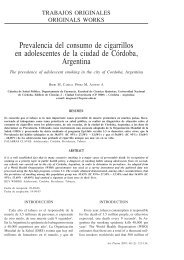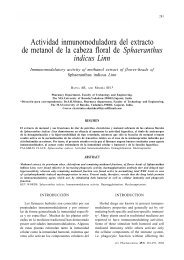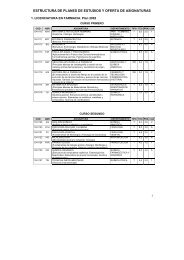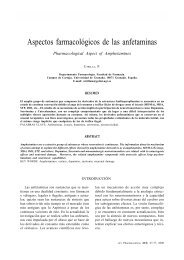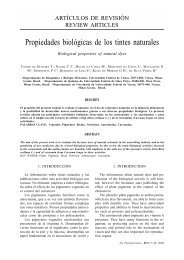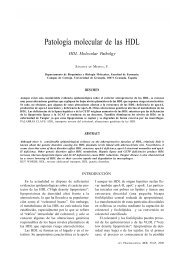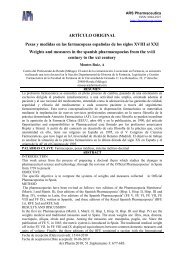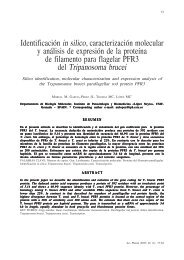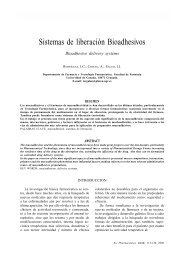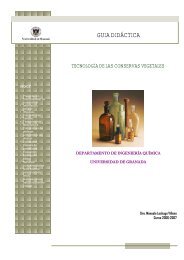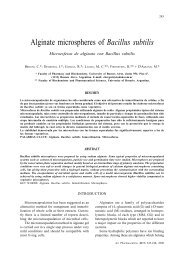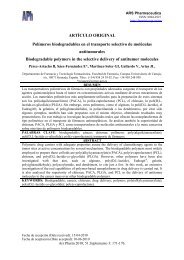Rifampicina y biodisponibilidad en productos combinados
Rifampicina y biodisponibilidad en productos combinados
Rifampicina y biodisponibilidad en productos combinados
You also want an ePaper? Increase the reach of your titles
YUMPU automatically turns print PDFs into web optimized ePapers that Google loves.
RIFAMPICINA Y BIODISPONIBILIDAD EN PRODUCTOS COMBINADOS<br />
RIFAMPICIN AND BIOAVAILABILITY IN COMBINATION FORMULATION<br />
<strong>Rifampicina</strong> y <strong>biodisponibilidad</strong> <strong>en</strong> <strong>productos</strong><br />
<strong>combinados</strong><br />
Rifampicin and bioavailability in combination formulation<br />
SOSA M, SZÉLIGA ME, FERNÁNDEZ A, BREGNI C<br />
Departam<strong>en</strong>to Departam<strong>en</strong>to de de Tecnología Tecnología Farmacéutica<br />
Farmacéutica<br />
Facultad Facultad de de Farmacia Farmacia Farmacia y y Bioquímica, Bioquímica, Bioquímica, Universidad Universidad de de Bu<strong>en</strong>os Bu<strong>en</strong>os Aires<br />
Aires<br />
Junín Junín Junín 956, 956, Piso Piso 6° 6° (1113) (1113) Bu<strong>en</strong>os Bu<strong>en</strong>os Aires, Aires, Aires, Arg<strong>en</strong>tina Arg<strong>en</strong>tina<br />
Arg<strong>en</strong>tina<br />
RESUMEN<br />
RESUMEN<br />
La La rifampicina rifampicina (R) (R) es es un un antibiótico antibiótico de de de primera primera primera elección elección <strong>en</strong> <strong>en</strong> el el tratami<strong>en</strong>to tratami<strong>en</strong>to de de la la tuberculosis tuberculosis tuberculosis (TB) (TB) (TB) junto junto<br />
junto<br />
a a la la Isoniazida Isoniazida (H), (H), Pirazinamida Pirazinamida (Z) (Z) y y Etambutol Etambutol Etambutol (E). (E). De De acuerdo acuerdo a a las las últimas últimas estadísticas, estadísticas, la la TB<br />
TB<br />
aum<strong>en</strong>tó aum<strong>en</strong>tó a a nivel nivel mundial mundial y y <strong>en</strong>tre <strong>en</strong>tre las las causas causas más más citadas citadas figuran: figuran: las las monoterapias, monoterapias, la la aparición aparición de de<br />
de<br />
microorganismos microorganismos resist<strong>en</strong>tes, resist<strong>en</strong>tes, la la car<strong>en</strong>cia car<strong>en</strong>cia de de de programas programas efectivos, efectivos, el el incumplimi<strong>en</strong>to incumplimi<strong>en</strong>to <strong>en</strong> <strong>en</strong> <strong>en</strong> el el tratami<strong>en</strong>to tratami<strong>en</strong>to y<br />
y<br />
las las dosis dosis erróneas. erróneas. erróneas. La La Organización Organización Mundial Mundial de de la la Salud Salud (OMS) (OMS) y y la la Unión Unión Internacional Internacional Internacional Contra Contra la<br />
la<br />
Tuberculosis Tuberculosis y y Enfermedades Enfermedades de de Pulmón Pulmón Pulmón (IUATLD) (IUATLD) declararon declararon a a la la <strong>en</strong>fermedad <strong>en</strong>fermedad <strong>en</strong> <strong>en</strong> emerg<strong>en</strong>cia emerg<strong>en</strong>cia emerg<strong>en</strong>cia mundial<br />
mundial<br />
yy establecieron establecieron programas programas terapéuticos terapéuticos para para asegurar asegurar el el cumplimi<strong>en</strong>to cumplimi<strong>en</strong>to cumplimi<strong>en</strong>to y y disminuir disminuir los los problemas problemas problemas relarela-<br />
cionados cionados a a la la la terapia. terapia. Sobre Sobre Sobre esta esta base, base, base, figura figura <strong>en</strong> <strong>en</strong> la la lista lista oficial oficial la la asociación asociación de de los los los cuatro cuatro fármacos fármacos fármacos de<br />
de<br />
primera primera línea línea línea R, R, Z, Z, H H y y E E E <strong>combinados</strong> <strong>combinados</strong> <strong>en</strong> <strong>en</strong> <strong>en</strong> dosis dosis fijas fijas (FDC) (FDC) que que permit<strong>en</strong> permit<strong>en</strong> la la administración administración conjunta conjunta de<br />
de<br />
los los mismos mismos y, y, <strong>en</strong> <strong>en</strong> las las dosis dosis correctas. correctas. Los Los Los <strong>productos</strong> <strong>productos</strong> FDC FDC son son recom<strong>en</strong>dados recom<strong>en</strong>dados oficialm<strong>en</strong>te oficialm<strong>en</strong>te por por por la la OMS<br />
OMS<br />
para para el el tratami<strong>en</strong>to tratami<strong>en</strong>to tratami<strong>en</strong>to de de la la TB. TB. TB. No No obstante obstante obstante exist<strong>en</strong> exist<strong>en</strong> factores factores que que alteran alteran la la <strong>biodisponibilidad</strong> <strong>biodisponibilidad</strong> <strong>biodisponibilidad</strong> de de la la R R <strong>en</strong><br />
<strong>en</strong><br />
estas estas formulaciones, formulaciones, hecho hecho ampliam<strong>en</strong>te ampliam<strong>en</strong>te reconocido reconocido <strong>en</strong> <strong>en</strong> publicaciones publicaciones ci<strong>en</strong>tíficas. ci<strong>en</strong>tíficas. ci<strong>en</strong>tíficas. El El objetivo objetivo de de este<br />
este<br />
trabajo trabajo es es estudiar estudiar los los los aspectos aspectos más más relevantes relevantes relevantes que que que alteran alteran la la <strong>biodisponibilidad</strong> <strong>biodisponibilidad</strong> de de la la R R <strong>en</strong> <strong>en</strong> los los <strong>productos</strong><br />
<strong>productos</strong><br />
FDC FDC y y plantear plantear posibles posibles soluciones soluciones al al al problema.<br />
problema.<br />
PALABRAS CLAVE: <strong>Rifampicina</strong>. Isoniazida. Productos FDC. Biodisponibilidad. Estabilidad. Polimorfismo.<br />
ABSTRACT<br />
ABSTRACT<br />
The The The The The drug drug drug drug drug rifampicin rifampicin rifampicin rifampicin rifampicin (R) (R) (R) (R) (R) is is is is is used used used used used as as as as as a a a a a first first first first first line line line line line antibiotic antibiotic antibiotic antibiotic antibiotic treatm<strong>en</strong>t treatm<strong>en</strong>t treatm<strong>en</strong>t treatm<strong>en</strong>t treatm<strong>en</strong>t for for for for for tuberculosis tuberculosis tuberculosis tuberculosis tuberculosis (TB), (TB), (TB), (TB), (TB), together together together together together with with with with with<br />
Isoniazide Isoniazide Isoniazide Isoniazide Isoniazide (H), (H), (H), (H), (H), Pyrazinamide Pyrazinamide Pyrazinamide Pyrazinamide Pyrazinamide (Z) (Z) (Z) (Z) (Z) and and and and and Ethambutol Ethambutol Ethambutol Ethambutol Ethambutol (E). (E). (E). (E). (E). According According According According According to to to to to rec<strong>en</strong>t rec<strong>en</strong>t rec<strong>en</strong>t rec<strong>en</strong>t rec<strong>en</strong>t statistics, statistics, statistics, statistics, statistics, there there there there there has has has has has be<strong>en</strong> be<strong>en</strong> be<strong>en</strong> be<strong>en</strong> be<strong>en</strong> an an an an an<br />
increase increase increase increase increase in in in in in TB TB TB TB TB on on on on on a a a a a worldwide worldwide worldwide worldwide worldwide scale, scale, scale, scale, scale, with with with with with the the the the the main main main main main causes causes causes causes causes being: being: being: being: being: monotherapies, monotherapies, monotherapies, monotherapies, monotherapies, the the the the the appearance appearance appearance appearance appearance of of of of of<br />
resistant resistant resistant resistant resistant microorganisms, microorganisms, microorganisms, microorganisms, microorganisms, the the the the the lack lack lack lack lack of of of of of effective effective effective effective effective prev<strong>en</strong>tative prev<strong>en</strong>tative prev<strong>en</strong>tative prev<strong>en</strong>tative prev<strong>en</strong>tative programs, programs, programs, programs, programs, non-compliance non-compliance non-compliance non-compliance non-compliance to to to to to treatm<strong>en</strong>t treatm<strong>en</strong>t treatm<strong>en</strong>t treatm<strong>en</strong>t treatm<strong>en</strong>t and and and and and<br />
mistak<strong>en</strong> mistak<strong>en</strong> mistak<strong>en</strong> mistak<strong>en</strong> mistak<strong>en</strong> dosage dosage dosage dosage dosage schedules. schedules. schedules. schedules. schedules. The The The The The world world world world world health health health health health organisation organisation organisation organisation organisation (WHO) (WHO) (WHO) (WHO) (WHO) and and and and and the the the the the International International International International International Union Union Union Union Union Against Against Against Against Against<br />
Tuberculosis Tuberculosis Tuberculosis Tuberculosis Tuberculosis and and and and and Lung Lung Lung Lung Lung Diseases(IUTALD) Diseases(IUTALD) Diseases(IUTALD) Diseases(IUTALD) Diseases(IUTALD) declared declared declared declared declared a a a a a state state state state state of of of of of emerg<strong>en</strong>cy emerg<strong>en</strong>cy emerg<strong>en</strong>cy emerg<strong>en</strong>cy emerg<strong>en</strong>cy with with with with with respect respect respect respect respect to to to to to the the the the the disease disease disease disease disease and and and and and<br />
established established established established established programs programs programs programs programs to to to to to increase increase increase increase increase compliance compliance compliance compliance compliance to to to to to therapy therapy therapy therapy therapy and and and and and to to to to to reduce reduce reduce reduce reduce the the the the the incid<strong>en</strong>ce incid<strong>en</strong>ce incid<strong>en</strong>ce incid<strong>en</strong>ce incid<strong>en</strong>ce of of of of of problems problems problems problems problems arising arising arising arising arising<br />
from from from from from such. such. such. such. such. Along Along Along Along Along these these these these these lines, lines, lines, lines, lines, a a a a a list list list list list of of of of of first first first first first line line line line line drug drug drug drug drug therapy therapy therapy therapy therapy treatm<strong>en</strong>ts treatm<strong>en</strong>ts treatm<strong>en</strong>ts treatm<strong>en</strong>ts treatm<strong>en</strong>ts were were were were were established, established, established, established, established, which which which which which<br />
included included included included included R, R, R, R, R, Z, Z, Z, Z, Z, H H H H H & & & & & E E E E E combinations combinations combinations combinations combinations at at at at at fixed fixed fixed fixed fixed dosage dosage dosage dosage dosage combinations combinations combinations combinations combinations (FDC), (FDC), (FDC), (FDC), (FDC), permitting permitting permitting permitting permitting safe safe safe safe safe combined combined combined combined combined<br />
administrations administrations administrations administrations administrations of of of of of the the the the the drugs drugs drugs drugs drugs at at at at at correct correct correct correct correct dosage dosage dosage dosage dosage levels. levels. levels. levels. levels. These These These These These fixed fixed fixed fixed fixed dose dose dose dose dose combinations combinations combinations combinations combinations have have have have have be<strong>en</strong> be<strong>en</strong> be<strong>en</strong> be<strong>en</strong> be<strong>en</strong> officially officially officially officially officially<br />
recomm<strong>en</strong>ded recomm<strong>en</strong>ded recomm<strong>en</strong>ded recomm<strong>en</strong>ded recomm<strong>en</strong>ded by by by by by the the the the the WHO WHO WHO WHO WHO in in in in in the the the the the treatm<strong>en</strong>t treatm<strong>en</strong>t treatm<strong>en</strong>t treatm<strong>en</strong>t treatm<strong>en</strong>t of of of of of TB. TB. TB. TB. TB. However, However, However, However, However, as as as as as has has has has has be<strong>en</strong> be<strong>en</strong> be<strong>en</strong> be<strong>en</strong> be<strong>en</strong> widely widely widely widely widely recognised recognised recognised recognised recognised in in in in in numerous numerous numerous numerous numerous<br />
sci<strong>en</strong>tific sci<strong>en</strong>tific sci<strong>en</strong>tific sci<strong>en</strong>tific sci<strong>en</strong>tific publications, publications, publications, publications, publications, in in in in in such such such such such formulations, formulations, formulations, formulations, formulations, there there there there there are are are are are factors factors factors factors factors that that that that that alter alter alter alter alter the the the the the bioavailability bioavailability bioavailability bioavailability bioavailability of of of of of R. R. R. R. R. The The The The The<br />
objective objective objective objective objective of of of of of this this this this this work work work work work has has has has has be<strong>en</strong> be<strong>en</strong> be<strong>en</strong> be<strong>en</strong> be<strong>en</strong> to to to to to study study study study study the the the the the most most most most most relevant relevant relevant relevant relevant aspects aspects aspects aspects aspects concerning concerning concerning concerning concerning R R R R R bioavailability bioavailability bioavailability bioavailability bioavailability alterations alterations alterations alterations alterations<br />
and and and and and to to to to to consider consider consider consider consider possible possible possible possible possible solutions solutions solutions solutions solutions to to to to to the the the the the problem. problem. problem. problem. problem.<br />
KEY WORDS: Rifampicin. Isoniazid. FDC products. Bioavailability. Stability. Polymorphism.<br />
353<br />
Ars Pharm 2005; 46 (4): 353-364.
354<br />
INTRODUCCIÓN<br />
Según datos estadísticos, 1.5 millones de<br />
personas muer<strong>en</strong> por año a causa de la tuberculosis<br />
1 y el 98 % de dichas muertes ocurr<strong>en</strong><br />
<strong>en</strong> países <strong>en</strong> desarrollo; estas cifras preocuparon<br />
a organismos internacionales, por lo que<br />
la OMS declaró a la <strong>en</strong>fermedad <strong>en</strong> emerg<strong>en</strong>cia<br />
mundial.<br />
En la actualidad se dispone de una amplia<br />
bibliografía con respecto a la <strong>biodisponibilidad</strong><br />
disminuida de la rifampicina (R) cuando<br />
se halla combinada <strong>en</strong> dosis fijas con isoniazida<br />
(H) pirazinamida (Z) y etambutol (E),<br />
fármacos de primera elección <strong>en</strong> el tratami<strong>en</strong>to<br />
de la TB 2 . La OMS y la IUATLD, publicaron<br />
un protocolo <strong>en</strong> 1999 que establece el<br />
uso de las cuatro drogas asociadas <strong>en</strong> dosis<br />
fijas R + H + Z + E (Tabla 1). Estas fórmulas<br />
permit<strong>en</strong> un mayor control de la terapia, previ<strong>en</strong><strong>en</strong><br />
la resist<strong>en</strong>cia a las drogas, simplifican<br />
el tratami<strong>en</strong>to, aseguran el cumplimi<strong>en</strong>to, favorec<strong>en</strong><br />
el suministro a los paci<strong>en</strong>tes y facilitan<br />
la prescripción.<br />
Ars Pharm 2005; 46 (4): 353-364.<br />
SOSA M, SZÉLIGA ME, FERNÁNDEZ A, BREGNI C<br />
INTRODUCTION<br />
According to statistical data, the death rate<br />
from tuberculosis 1 is as high as 1.5 million<br />
people per year, of which 98% of such deaths<br />
occur in developing countries. The magnitude<br />
of these figures is a source of great concern<br />
for international organisations, and it is<br />
for this reason that the WHO has declared a<br />
state of world emerg<strong>en</strong>cy.<br />
A great number of articles dealing with the<br />
reduced bioavailability of rifampicin (R), used<br />
in combination with isoniazide (H), pyrazinamide<br />
(z) and ethambutol (E), have be<strong>en</strong> published<br />
over rec<strong>en</strong>t years. These drugs are<br />
considered as first line treatm<strong>en</strong>ts for TB 2 , for<br />
which the WHO and the IUATLD published a<br />
protocol in 1999, establishing the combined<br />
use of the four associated drugs at fixed dosages.<br />
(Table 1). The aims of the protocol were<br />
to attain; greater control of the therapy, prev<strong>en</strong>t<br />
resistance to the drugs, simplify treatm<strong>en</strong>t,<br />
to assure adequate compliance to treatm<strong>en</strong>t,<br />
to facilitate disp<strong>en</strong>sation to pati<strong>en</strong>ts and<br />
to simplify prescription procedures.<br />
TABLA TABLA 1. 1.<br />
1. Asociaciones de la <strong>Rifampicina</strong> con las drogas de 1° línea dada por la OMS.<br />
TABLE TABLE 1. 1.<br />
1. Associations of Rifampicin with WHO first line drugs.<br />
Drogas Forma farmacéutica Fórmula Indicada para uso diario<br />
Drug Pharmaceutical form Suitable formulation for daily use<br />
RHZE Comprimidos R (150 mg) + H (75 mg)+ Z (400 mg) + E (275 mg)<br />
Tablet<br />
RHZ Comprimidos R (150 mg) + H (75 mg) + Z (400 mg)<br />
Tablet<br />
Comp. Dispersables R (60 mg) + H (30 mg) + Z (150 mg)<br />
Tablet Dispersible<br />
RH Comprimidos R (300 mg) + H (150 mg)<br />
Tablet<br />
Comprimidos R (150 mg) + H (75 mg)<br />
Tablet<br />
Comp. Dispersables R (60 mg) + H (30 mg)<br />
Tablet Dispersible<br />
EH Comprimidos E (400 mg) + H (150 mg)<br />
Tablet
RIFAMPICINA Y BIODISPONIBILIDAD EN PRODUCTOS COMBINADOS<br />
RIFAMPICIN AND BIOAVAILABILITY IN COMBINATION FORMULATION<br />
Si bi<strong>en</strong> la combinación de los cuatro fármacos<br />
m<strong>en</strong>cionados pone de manifiesto las<br />
últimas recom<strong>en</strong>daciones dadas por los organismos<br />
internacionales, también figuran <strong>en</strong> la<br />
lista oficial la asociación de tres drogas R + H<br />
+ Z para el tratami<strong>en</strong>to <strong>en</strong> adultos y <strong>en</strong> m<strong>en</strong>or<br />
conc<strong>en</strong>tración para uso pediátrico. La combinación<br />
de dos drogas es<strong>en</strong>ciales R + H fue<br />
una de las primeras asociaciones y, según el<br />
tipo de infección, es considerablem<strong>en</strong>te utilizada.<br />
Por lo expuesto, resulta de fundam<strong>en</strong>tal<br />
importancia mejorar la <strong>biodisponibilidad</strong> de<br />
la rifampicina pres<strong>en</strong>te <strong>en</strong> todas las combinaciones.<br />
En consecu<strong>en</strong>cia, es necesario estudiar<br />
su estabilidad, los aspectos más relevantes<br />
de la fase sólida, las interacciones con<br />
excipi<strong>en</strong>tes, las propiedades fisicoquímicas y<br />
biofarmacéuticas más importantes, con el objeto<br />
de lograr formulaciones estables que garantic<strong>en</strong><br />
una óptima absorción de los fármacos.<br />
Estabilidad y Aspectos Biofarmacéuticos<br />
D<strong>en</strong>tro de las formulaciones FDC, la R es<br />
el compon<strong>en</strong>te más crítico <strong>en</strong> cuanto a la estabilidad<br />
y <strong>biodisponibilidad</strong>. En ord<strong>en</strong> creci<strong>en</strong>te<br />
de estabilidad le sigue la isoniazida y<br />
la pirazinamida 3 . Hay muy poca información<br />
bibliográfica <strong>en</strong> relación a la estabilidad del<br />
etambutol.<br />
La R es ligeram<strong>en</strong>te soluble <strong>en</strong> agua y etanol.<br />
La solubilidad <strong>en</strong> agua es pH dep<strong>en</strong>di<strong>en</strong>te:<br />
a pH 2 es de 100 mg/ml; a pH 5,3 disminuye<br />
a 4 mg/ml y a pH 7,5 se reduce a 2,8<br />
mg/ml. La solubilidad de la R <strong>en</strong> agua puede<br />
ser increm<strong>en</strong>tada por la adición de ácido ascórbico.<br />
La droga ti<strong>en</strong>e un pKa de 1,7 y 7,9 4<br />
Los <strong>productos</strong> que conti<strong>en</strong><strong>en</strong> R deb<strong>en</strong> ser<br />
protegidos de la exposición al aire, la humedad,<br />
la luz y al calor excesivo (40 °C o más).<br />
En pH alcalino de 7,5 a 9,0 la R sufre una<br />
degradación oxidativa <strong>en</strong> pres<strong>en</strong>cia de oxig<strong>en</strong>o,<br />
a temperatura ambi<strong>en</strong>te, formando la rifampicina<br />
quinona. Esta oxidación puede ser<br />
disminuida por la adición de ácido ascórbico.<br />
El pH de máxima estabilidad esta cerca de la<br />
neutralidad 5 . A pH ácidos la droga esta sujeta<br />
a catálisis ácida (descomposición de la droga<br />
in situ <strong>en</strong> el estómago), así sufre una hidróli-<br />
355<br />
The protocol not only outlines recomm<strong>en</strong>dations<br />
for the combined use of the four drugs,<br />
but also officially recomm<strong>en</strong>ds combinations<br />
of three drugs, R+H+Z, for treatm<strong>en</strong>t in adults,<br />
as well as the same combination for paediatric<br />
use at lower conc<strong>en</strong>trations. The use of<br />
two of the ess<strong>en</strong>tial drugs R+H was one of the<br />
first combinations to have be<strong>en</strong> established,<br />
and in accordance with the type of infection<br />
concerned, is one that is still widely used.<br />
Giv<strong>en</strong> that rifampicin is the drug that is<br />
common to all of the combinations, it is therefore<br />
of fundam<strong>en</strong>tal importance that its bioavailability<br />
is improved. Further study is therefore<br />
necessary to discover its stability, aspects<br />
regarding solid phase, interactions with excipi<strong>en</strong>ts,<br />
as well as the most important physicochemical<br />
and biopharmaceutical properties, as<br />
a means to achieving stable formulations which<br />
guarantee optimal absorption of the drugs.<br />
Stability and Biopharmaceutical Aspects<br />
In FDC formulations, R is the most critical<br />
compon<strong>en</strong>t with regard to stability and bioavailability.<br />
In increasing order of stability<br />
isoniazide and pyrazinamide 3 follow . However,<br />
there is little bibliographical information<br />
available with regard to the stability of ethambutol.<br />
R is slightly soluble in water and ethanol.<br />
at pH 2 it is 100mg/ml, at pH 5.3 it is reduced<br />
to 4mg/ml and at pH 7.5 reduces to 2.8 mg/<br />
ml. R solubility in water can be increased by<br />
adding ascorbic acid. The drug has a pKa of<br />
1.7 and 7.9 4 .<br />
Products containing R should be protected<br />
from exposure to air, humidity, light and excessive<br />
heat (40° or more). Under alkaline pH<br />
conditions of betwe<strong>en</strong> 7.5 to 9.0, R undergoes<br />
oxidative degradation in the pres<strong>en</strong>ce of<br />
oxyg<strong>en</strong>, at room temperature, forming rifampicin-quinone.<br />
Such an oxidation can be reduce<br />
through the addition of ascorbic acid.<br />
Maximum R stability is found to exist at pH<br />
values close to neutrality 5 . For acid pH values,<br />
the drug is subject to acid catalysis (decomposition<br />
of the drug in situ in the stomach)<br />
and consequ<strong>en</strong>tly undergoes a process of<br />
specific hydrolysis giving 3-formyl rifamycin<br />
and 1-amino 4-methyl piperazine. The phos-<br />
Ars Pharm 2005; 46 (4): 353-364.
356<br />
sis especifica obt<strong>en</strong>iéndose el 3-formil- rifampicina<br />
y el 1-amino-4-metil piperazina. Los<br />
buffer fosfato también catalizan la descomposición.<br />
La descomposición que sufre la R <strong>en</strong> medio<br />
ácido aum<strong>en</strong>ta <strong>en</strong> forma significativa <strong>en</strong><br />
pres<strong>en</strong>cia de la H. Singh S. et al 6 . comprobaron<br />
el mecanismo por el cual ocurre la reacción<br />
de degradación y se id<strong>en</strong>tificaron los<br />
<strong>productos</strong> y la cinética de estos procesos. Así<br />
la R se descompone <strong>en</strong> 3 formil-rifampicina y<br />
<strong>en</strong> la 1-amino-4-metil piperazina mediante una<br />
reacción de primer ord<strong>en</strong>, luego la 3-formilrifampicina<br />
reacciona mediante una reacción<br />
de segundo ord<strong>en</strong> con la H formando una<br />
hidrazona (isonicotinil hidrazona) (Figura I).<br />
La inestabilidad de la hidrazona resulta <strong>en</strong> la<br />
reg<strong>en</strong>eración de la isoniazida y la 3-formil<br />
rifampicina por una reacción de pseudoprimer<br />
ord<strong>en</strong>. Como se observa <strong>en</strong> la figura 1<br />
este equilibrio esta desplazado hacia la formación<br />
de la hidrazona que fue aislada y<br />
caracterizada. Este mecanismo conduce a la<br />
degradación de la R <strong>en</strong> pres<strong>en</strong>cia de H y explica<br />
los resultados obt<strong>en</strong>idos <strong>en</strong> los <strong>en</strong>sayos realizados<br />
a distintas formulaciones, <strong>en</strong> donde la<br />
R sola, <strong>en</strong> las mismas condiciones, se descompone<br />
<strong>en</strong> un promedio que no excede el<br />
6.33 %; mi<strong>en</strong>tras que asociada a la H el promedio<br />
de descomposición aum<strong>en</strong>ta al 16,32<br />
%. De esta manera se explica su baja estabilidad<br />
y disminuida <strong>biodisponibilidad</strong>. No se<br />
<strong>en</strong>contraron modificaciones <strong>en</strong> los porc<strong>en</strong>tajes<br />
de degradación de R cuando esta combinada<br />
con la Z y/o el E 7 , drogas que no intervi<strong>en</strong><strong>en</strong><br />
<strong>en</strong> la reacción ni modifican la estabilidad<br />
de los otros compon<strong>en</strong>tes.<br />
Ars Pharm 2005; 46 (4): 353-364.<br />
SOSA M, SZÉLIGA ME, FERNÁNDEZ A, BREGNI C<br />
phate buffers also catalyse this decomposition.<br />
R decomposition in acid media increases<br />
significantly in the pres<strong>en</strong>ce of H. Singh et al 6<br />
id<strong>en</strong>tified the mechanism through which this<br />
reaction occurs, as well as the products and<br />
kinetic processes involved. R decomposes,<br />
through a first order reaction, in 3-formylrifamycin<br />
and 1-amino 4-methyl piperazine, and<br />
subsequ<strong>en</strong>tly, a second order reaction occurs<br />
betwe<strong>en</strong> 3-formyl rifamycin and H, forming a<br />
hydrazone (Isonicotinyl hydrazone) (Figure 1).<br />
Hydrazone instability results in 3-formylrifamicyn<br />
and H reg<strong>en</strong>eration through a pseudo<br />
first order reaction. As shown in figure 1, this<br />
equilibrium is displaced towards the formation<br />
of hydrazone, which was subsequ<strong>en</strong>tly<br />
isolated and characterised. It is through this<br />
mechanism that R degradation takes place in<br />
the pres<strong>en</strong>ce of H and serves as a basis from<br />
which the results obtained from differ<strong>en</strong>t tests<br />
carried out on differ<strong>en</strong>t formulations may be<br />
evaluated. R alone under the same conditions<br />
decomposes at an average of no more than<br />
6.33%, while decomposition rates in association<br />
with H reach averages of 16.32%. It is<br />
through such a process that the low stability<br />
and reduced bioavailability of R can be explained.<br />
Modifications in R degradation perc<strong>en</strong>tages<br />
were not found wh<strong>en</strong>, combined with<br />
Z and/or E 7 , which are drugs that neither interv<strong>en</strong>e<br />
in the reaction, or modify the stability<br />
of other compon<strong>en</strong>ts.
RIFAMPICINA Y BIODISPONIBILIDAD EN PRODUCTOS COMBINADOS<br />
RIFAMPICIN AND BIOAVAILABILITY IN COMBINATION FORMULATION<br />
FIGURA FIGURA 1. 1.<br />
1. mecanismo de descomposición de la <strong>Rifampicina</strong> <strong>en</strong> pres<strong>en</strong>cia de Isoniazida <strong>en</strong> medio ácido.<br />
FIGURE FIGURE 1. 1. The decomposition mechanism of Rifampicin in the pres<strong>en</strong>ce of Isoniazide <strong>en</strong> acid medium.<br />
Estos estudios realizados in-vitro pued<strong>en</strong><br />
compararse con otras investigaciones que se<br />
llevaron a cabo in-vivo. Shishoo et al 8 <strong>en</strong> un<br />
trabajo realizado <strong>en</strong> voluntarios sanos determinaron<br />
distintos parámetros farmacocinéticos<br />
de la R y de su metabolito activo 25-desacetilrifampicina<br />
(25-DAR). Se midieron los niveles<br />
de excreción urinaria de formulaciones<br />
con R como único compon<strong>en</strong>te y de formulaciones<br />
con R + H . Se observó una disminución<br />
<strong>en</strong> la cantidad excretada del 27,90 %<br />
para R, y del 32,35 % para su metabolito activo<br />
25 –DAR, <strong>en</strong> relación a las formulaciones que<br />
357<br />
The results obtained from these in-vitro<br />
studies are comparable to those obtained from<br />
other in-vivo studies. Shishoo et al 8 determined<br />
differ<strong>en</strong>t pharmacokinetic parameters of<br />
R and of its active metabolite 25-des-acetyl<br />
rifampicyn (25 DAR) in a study carried out<br />
on healthy volunteers, in which levels of R<br />
alone and co-administered R + H formulations<br />
were determined from urine samples. A<br />
decrease in the excreted quantity of 27.90%<br />
was observed for R and 32.35% for its active<br />
metabolite 25 DAR, in comparison with formulations<br />
containing R alone. Decreases in<br />
Ars Pharm 2005; 46 (4): 353-364.
358<br />
conti<strong>en</strong><strong>en</strong> R sola. Las disminuciones <strong>en</strong> el área<br />
bajo la curva ( AUC 0-24) fueron de un 34,24<br />
% y 29,26 % para la R y 25-DAR respectivam<strong>en</strong>te.<br />
Desde el aspecto biofarmacéutico, es necesario<br />
destacar que la R pert<strong>en</strong>ece a la clase<br />
II <strong>en</strong> el Sistema de Clasificación Biofarmacéutico,<br />
sustancia de baja solubilidad y alta<br />
permeabilidad, mi<strong>en</strong>tras que los otros compon<strong>en</strong>tes<br />
Z, H y E pert<strong>en</strong>ec<strong>en</strong> a la clase I, alta<br />
solubilidad y alta permeabilidad. Por esta razón<br />
la R resulta ser el compon<strong>en</strong>te más limitante<br />
de los <strong>productos</strong> FDC.<br />
Además, la R es una molécula compleja<br />
que ti<strong>en</strong>e difer<strong>en</strong>tes conformaciones de acuerdo<br />
a las interacciones <strong>en</strong>tre sus grupos funcionales<br />
g<strong>en</strong>erando distintos hábitos cristalinos. Los<br />
procesos involucrados <strong>en</strong> la manufactura tales<br />
como la moli<strong>en</strong>da, el mezclado, la granulación<br />
y el secado pued<strong>en</strong> modificar la naturaleza<br />
cristalina de la droga. Por este motivo,<br />
es indisp<strong>en</strong>sable hacer un seguimi<strong>en</strong>to <strong>en</strong> las<br />
distintas etapas de elaboración del producto<br />
terminado a fin de no producir cambios cristalinos<br />
<strong>en</strong> el principio activo y <strong>en</strong> consecu<strong>en</strong>cia<br />
no dar lugar a una modificación <strong>en</strong> la liberación<br />
de la R. Asimismo, los excipi<strong>en</strong>tes<br />
comúnm<strong>en</strong>te usados <strong>en</strong> la preparación de los<br />
comprimidos tales como el talco, b<strong>en</strong>tonita o<br />
caolín, adsorb<strong>en</strong> la R y disminuy<strong>en</strong> su liberación<br />
<strong>en</strong> el tracto gastrointestinal.<br />
Estudios realizados sobre fase sólida<br />
El polimorfismo es una de las causas más<br />
citadas <strong>en</strong> la literatura porque ti<strong>en</strong>e gran influ<strong>en</strong>cia<br />
<strong>en</strong> la <strong>biodisponibilidad</strong> del principio<br />
activo y <strong>en</strong> consecu<strong>en</strong>cia <strong>en</strong> la efectividad del<br />
tratami<strong>en</strong>to. La R pres<strong>en</strong>ta polimorfismo, una<br />
de las propiedades más importantes del estado<br />
sólido que debe considerarse <strong>en</strong> las etapas<br />
de desarrollo del producto terminado. Las<br />
distintas estructuras cristalinas se deb<strong>en</strong> a interacciones<br />
moleculares tales como pu<strong>en</strong>tes de<br />
hidrog<strong>en</strong>o, cambios conformacionales y estados<br />
de ionización que ocasionan reord<strong>en</strong>ami<strong>en</strong>tos<br />
moleculares, se forma una celda unitaria y<br />
la repetición de la misma, forma un retículo<br />
cristalino que caracteriza al cristal. La estructura<br />
cristalina adoptada por una sustancia activa<br />
ejerce cambios sobre las propiedades del es-<br />
Ars Pharm 2005; 46 (4): 353-364.<br />
SOSA M, SZÉLIGA ME, FERNÁNDEZ A, BREGNI C<br />
the area under the curve (AUC 0-24) O-24) were<br />
34.24% and 29.26% for R and 25-DAR respectively.<br />
From a bio pharmaceutical point of view,<br />
it should be pointed out that in the Biopharmaceutical<br />
Classification System, R is classified<br />
as a Type II substance of low solubility<br />
and high permeability, while other the compon<strong>en</strong>ts<br />
Z, H & E belong to type I substances<br />
of high solubility and high permeability. For<br />
this reason, the R compon<strong>en</strong>t is the main limiting<br />
factor in FDC products.<br />
Furthermore, the R molecule is a complex<br />
one, which pres<strong>en</strong>ts differ<strong>en</strong>t conformations<br />
in accordance with interactions betwe<strong>en</strong> its<br />
functional groups, g<strong>en</strong>erating differ<strong>en</strong>t crystalline<br />
habits. Differ<strong>en</strong>t processes involved in<br />
the elaboration of the drug, such as grinding,<br />
mixing, granulation or drying may alter the<br />
crystalline nature of the drug. It is therefore<br />
ess<strong>en</strong>tial to monitor the differ<strong>en</strong>t stages of<br />
elaboration of the finished product, so as to<br />
guard against changes in the crystal habit of<br />
the active principle and the consequ<strong>en</strong>t changes<br />
in R liberation capacity. It should also be<br />
tak<strong>en</strong> into account that commonly used excipi<strong>en</strong>ts,<br />
in the preparation of tablet formulations,<br />
such as talc, b<strong>en</strong>tonite and kaolin may<br />
adsorb R and therefore reduce its liberation<br />
within the gastrointestinal tract.<br />
Solid phase studies<br />
According to many bibliographic refer<strong>en</strong>ces,<br />
polymorphism is one of the most influ<strong>en</strong>tial<br />
factors in the bioavailability of active principle<br />
and the effectiv<strong>en</strong>ess of treatm<strong>en</strong>t. The<br />
polymorphic nature of R in solid state form is<br />
one of the most important properties to be<br />
tak<strong>en</strong> into account throughout the stages of<br />
developm<strong>en</strong>t of the finished product. The differ<strong>en</strong>t<br />
crystalline structures formed are dep<strong>en</strong>d<strong>en</strong>t<br />
upon molecular interactions, such as<br />
hydrog<strong>en</strong> bridges, changes in conformation<br />
and ionization states, which cause molecular<br />
reorganisation, forming unitary cells and their<br />
repetition, which in turn produce a crystalline<br />
reticule that characterises the crystal. The crystalline<br />
structure adopted by the active substance<br />
causes changes in the properties of solid<br />
state formations to take place. These changes
RIFAMPICINA Y BIODISPONIBILIDAD EN PRODUCTOS COMBINADOS<br />
RIFAMPICIN AND BIOAVAILABILITY IN COMBINATION FORMULATION<br />
tado sólido, como ser, la solubilidad, punto<br />
de fusión, d<strong>en</strong>sidad, velocidad de disolución,<br />
índice de refracción, volum<strong>en</strong>, dureza del cristal,<br />
higroscopicidad, velocidad de reacción, estabilidad,<br />
<strong>en</strong>talpía y diagramas de fase <strong>en</strong>tre otros.<br />
Todas están determinadas por la naturaleza<br />
del estado cristalino. Para id<strong>en</strong>tificar un polimorfo<br />
es necesario utilizar métodos espectroscópicos<br />
y termales conjuntam<strong>en</strong>te.<br />
En 1977, Pelizza et al. 9 demuestran que la<br />
compleja estructura de la molécula de R muestra<br />
polimorfismo. Caracterizan al polimorfo I, al<br />
polimorfo II y a la forma amorfa. Los métodos<br />
de análisis espectroscópicos utilizados<br />
fueron, espectroscopia infrarroja (FTIR) y Rayos<br />
X (XRPD) estableci<strong>en</strong>do los patrones de id<strong>en</strong>tidad<br />
para cada sustancia. Se correlacionan con<br />
los métodos termográficos de calorimetría<br />
difer<strong>en</strong>cial de barrido (DSC) y termogravimetría<br />
(TG) que se tomaron como termogramas<br />
patrones para los estudios posteriores.<br />
Resulta interesante destacar que los distintos<br />
tipos de interacciones vibracionales de los<br />
grupos funcionales de la molécula de R difier<strong>en</strong><br />
<strong>en</strong> los difer<strong>en</strong>tes polimorfos. La ori<strong>en</strong>tación<br />
espacial de los átomos adquiere una difer<strong>en</strong>te<br />
conformación originando una estructura<br />
cristalina determinada <strong>en</strong> cada caso. En la R<br />
amorfa el grupo acetilo del C 35 adquiere dos<br />
conformaciones difer<strong>en</strong>tes que impid<strong>en</strong> la<br />
formación de una forma cristalina.<br />
En los estudios de H<strong>en</strong>wood et al. 10 fueron<br />
aislados difer<strong>en</strong>tes solvatos e hidratos por<br />
recristalización <strong>en</strong> varios sistemas de solv<strong>en</strong>tes<br />
a partir del polimorfo II que se considero<br />
como R patrón. Se obtuvo una rifampicina<br />
monohidrato, una rifampicina dihidrato, 1:1<br />
rifampicina:acetona solvato, 1:2 rifampicina:2pirrolidona<br />
solvato y dos formas amorfas. Todas<br />
las formas cristalinas fueron analizadas por<br />
Microscopía Electrónica de Barrido (MEB) y<br />
caracterizadas por análisis térmicos, métodos<br />
espectroscópicos y medidas de la velocidad<br />
de disolución. Se observó que hidratos y solvatos<br />
pasan a la forma amorfa después de la<br />
desolvatación, con excepción de la 2-pirrolidona<br />
solvato. El caso de la formación de hidratos<br />
a partir de solv<strong>en</strong>tes como el etanol<br />
absoluto y el b<strong>en</strong>c<strong>en</strong>o, nos hace p<strong>en</strong>sar que la<br />
R existe con moléculas de agua de cristalización<br />
que se ord<strong>en</strong>an d<strong>en</strong>tro de la red cristalina.<br />
En cuanto a los amorfos, contrariam<strong>en</strong>te a<br />
359<br />
can affect properties such as solubility, fusion<br />
points, d<strong>en</strong>sity, dissolution velocity, refraction<br />
index, volume, crystal hardness, hygroscopicity,<br />
reaction speed, stability, <strong>en</strong>thalpy and<br />
phase diagrams among others, which are all<br />
determined by the nature of the crystalline state.<br />
In order to id<strong>en</strong>tify a polymorph, spectroscopic<br />
and thermal methods should be used jointly<br />
In 1977, Pelizza et al. 9 showed that the<br />
complex R molecule structure shows a polymorphic<br />
behaviour, characterising polymorph<br />
I, II and the amorphous form. The spectroscopic<br />
analysis methods used were infrared<br />
spectroscopy (FTIR) and X rays (XRPD), which<br />
allowed the id<strong>en</strong>tity patterns of each substance<br />
to be determined. These were subsequ<strong>en</strong>tly<br />
correlated through differ<strong>en</strong>tial scanning<br />
calorimetry (DSC) and thermo gravimetric<br />
analysis (TGA), from which thermo gram<br />
patterns were tak<strong>en</strong> for use in subsequ<strong>en</strong>t studies.<br />
It is of interest to note that the differ<strong>en</strong>t<br />
types of vibrational interactions of the functional<br />
groups of the R molecule are differ<strong>en</strong>t<br />
in differ<strong>en</strong>t polymorphs. The spatial ori<strong>en</strong>tation<br />
of the atoms acquire a differ<strong>en</strong>t conformation,<br />
which produce a determined crystalline<br />
structure in every case. In the amorphous<br />
R, the C35 acetyl group acquires two differ<strong>en</strong>t<br />
conformations, which prev<strong>en</strong>t the formation<br />
of crystalline forms.<br />
In studies carried out by H<strong>en</strong>wood et al. 10<br />
differ<strong>en</strong>t hydrates and solvates were isolated<br />
through re-crystallization in numerous solv<strong>en</strong>t<br />
systems from polymorph II, which was considered<br />
as R pattern. A rifampicin monohydrated,<br />
a rifampicin dehydrate, 1:1 rifampicin<br />
acetone solvate, 1:2 rifampicin 2-pyrrolidone<br />
solvate and two amorphous forms were obtained.<br />
All crystalline forms were analysed through<br />
sweeping electronic microscopy (SEM), and<br />
characterized through thermal analysis, spectroscopy<br />
and dissolution velocity evaluation.<br />
Hydrates and solvates were se<strong>en</strong> to transform<br />
into amorphous forms, after desolvation, with<br />
the exception of 2- pyrrolidine solvate. The<br />
formation of hydrates from solv<strong>en</strong>ts, such as<br />
absolute ethanol and b<strong>en</strong>z<strong>en</strong>e, leads us to<br />
believe that R is pres<strong>en</strong>t in conjunction with<br />
water of crystallisation, which are ordered<br />
within the crystal network. Contrary to what<br />
Ars Pharm 2005; 46 (4): 353-364.
360<br />
lo esperado, pres<strong>en</strong>tan m<strong>en</strong>or velocidad de<br />
disolución. Este comportami<strong>en</strong>to se puede<br />
explicar considerando que las partículas muy<br />
finas del amorfo se agregan por fuerzas electrostáticas<br />
formando los d<strong>en</strong>ominados «lump»<br />
que disminuy<strong>en</strong> la disolución del polvo. Los<br />
resultados muestran que la solubilidad <strong>en</strong> ClH<br />
0,1 N, simulando las condiciones del estómago,<br />
es la sigui<strong>en</strong>te: dihidrato ≥ monohidrato ><br />
acetona solvato > polimorfo II > amorfo I ><br />
2-pirrolidona solvato > amorfo II. Este hecho<br />
indicaría que el dihidrato podría ser la forma<br />
cristalina con mayor performance in vivo.<br />
En un trabajo reci<strong>en</strong>te, Panchagnula et al 11<br />
analizaron los polimorfos I y II, ambos suministrados<br />
por el Laboratorio Lupin Ltd (Mumbai,<br />
India), mi<strong>en</strong>tras que la forma amorfa fue<br />
desarrollada por los autores. Se estudiaron<br />
además muestras comerciales de R adquiridas<br />
del comercio internacional. La caracterización<br />
se realizó por los métodos espectroscópicos y<br />
termales ya m<strong>en</strong>cionados además de mostrar<br />
una técnica termomicroscópica donde se observan<br />
los ev<strong>en</strong>tos térmicos bajo luz polarizada<br />
(Leitz 1350, Leica, Germany). El termograma<br />
DSC de los polimorfos y del amorfo<br />
muestra los ev<strong>en</strong>tos térmicos: <strong>en</strong> la forma I<br />
solo se observa una exoterma de descomposición<br />
a los 261°C. La forma II muestra una<br />
<strong>en</strong>doterma de fusión a 189°C seguida de una<br />
exoterma de recristalización a la forma I a<br />
204°C, transición sólido-liquido-sólido, que<br />
finalm<strong>en</strong>te se descompone a 258 °C. El amorfo<br />
pres<strong>en</strong>ta ev<strong>en</strong>tos exotérmicos con descomposición<br />
a 258°C. Estos comportami<strong>en</strong>tos térmicos<br />
coincid<strong>en</strong> con las transiciones de los<br />
cristales observados con luz microscópica. Los<br />
termogramas por DSC descriptos nos permite<br />
establecer la relación termodinámica <strong>en</strong>tre los<br />
dos polimorfos, la formación de la forma cristalina<br />
I, después del cal<strong>en</strong>tami<strong>en</strong>to de la forma<br />
II, es un proceso irreversible, lo que indica<br />
que la forma I puede ser obt<strong>en</strong>ida por<br />
cal<strong>en</strong>tami<strong>en</strong>to de la forma II y ambos polimorfos<br />
exhib<strong>en</strong> una relación monotrópica. En<br />
base a los datos de fusión obt<strong>en</strong>idos se puede<br />
establecer que la forma I es estable mi<strong>en</strong>tras<br />
que la forma II es metaestable. El termograma<br />
del amorfo sugiere bu<strong>en</strong>a estabilidad termodinámica<br />
con descomposición a 258°C.<br />
Las difer<strong>en</strong>cias <strong>en</strong> las uniones pu<strong>en</strong>tes de<br />
hidrog<strong>en</strong>o de la forma I, II y amorfo son dadas<br />
Ars Pharm 2005; 46 (4): 353-364.<br />
SOSA M, SZÉLIGA ME, FERNÁNDEZ A, BREGNI C<br />
was expected, amorphous forms pres<strong>en</strong>ted low<br />
dissolution velocities. This behaviour may be<br />
explained by the fact that the very fine particles<br />
of the amorphous form are clustered together<br />
through electrostatic forces, forming so<br />
called «lumps», which reduce the dissolution<br />
speed of the powder. The results show that<br />
the solubility in ClH 0,1 N, which simulate<br />
conditions in the stomach, are as follows:<br />
dehydrate ≥ monohydrate > acetone solvate ><br />
polymorph II > amorphous I > 2-pyrrolidone<br />
solvate > amorphous II. This indicates that<br />
the dehydrate could be the crystalline form<br />
that yields the highest performance in vivo.<br />
In a rec<strong>en</strong>t work, Panchagnula et al 11 analysed<br />
polymorphs I and II, both supplied by Lupin<br />
Laboratories Ltd (Mumbai, India), as well as<br />
the amorphous form, developed by the authors<br />
themselves. Commercial samples of R<br />
acquired from the international market were<br />
also studied, and characterisation was carried<br />
out through the previously m<strong>en</strong>tioned thermal<br />
and spectroscopic methods. A thermo microscopic<br />
technique was also used in this study,<br />
which observed thermal ev<strong>en</strong>ts under polarised<br />
light (Leitz 1350, Leica, Germany). The<br />
thermo gram (DSC) of polymorphic and amorphic<br />
forms shows the thermal ev<strong>en</strong>ts that took<br />
place: Form I only demonstrates an exothermic<br />
decomposition at 261°C, form II, an <strong>en</strong>dothermic<br />
fusion at 189°C, followed by an<br />
exotherm of re-crystallisation to form I at<br />
258°C. The amorphous form pres<strong>en</strong>ts exothermal<br />
ev<strong>en</strong>ts with decomposition taking place<br />
at 258°C. These thermal behaviour patterns<br />
coincide with the transition of crystals observed<br />
with microscopic light. The DSC thermo<br />
grams described, allow us to establish the<br />
exist<strong>en</strong>ce of a dynamic thermal relationship<br />
betwe<strong>en</strong> the two polymorphs. The formation<br />
of crystalline form I, after heating form II, is<br />
an irreversible process. This indicates that form<br />
I may be obtained through heating form II<br />
and that both polymorphs exhibit a monotropic<br />
relationship. On the basis of the fusion<br />
information obtained, it can be established that<br />
form I is stable, while form II is metastable.<br />
The thermo gram of the amorphous form suggests<br />
good thermodynamic stability with<br />
decomposition at 258°C.<br />
Differ<strong>en</strong>ces in the hydrog<strong>en</strong> bridge links<br />
betwe<strong>en</strong> forms I and II and the amorphous
RIFAMPICINA Y BIODISPONIBILIDAD EN PRODUCTOS COMBINADOS<br />
RIFAMPICIN AND BIOAVAILABILITY IN COMBINATION FORMULATION<br />
por espectroscopia FTIR y, <strong>en</strong> el difractograma<br />
por XRPD se observan los patrones característicos<br />
de difracción de ambos polimorfos.<br />
También, se realizaron los espectros de Resonancia<br />
Magnética Nuclear (NMR) y se diseñaron<br />
los modelos moleculares. Los factores<br />
tales como tamaño de partícula, velocidad de<br />
disolución intrínseca a distintos valores de pH<br />
fueron analizados. Resulta relevante, que el<br />
tamaño de partícula de las muestras comerciales<br />
tuvo más impacto <strong>en</strong> la velocidad de<br />
disolución, que el polimorfismo. Muestras con<br />
tamaño de partícula por debajo de las 100 µm<br />
mostraron una alta velocidad de disolución<br />
indep<strong>en</strong>di<strong>en</strong>tem<strong>en</strong>te del polimorfo involucrado,<br />
mi<strong>en</strong>tras que partículas por <strong>en</strong>cima de las<br />
100 µm muestran una baja disolución. Las<br />
muestras comerciales analizadas resultaron ser<br />
una mezcla de polimorfo I, polimorfo II y<br />
amorfo.<br />
Interacciones con excipi<strong>en</strong>tes y otros fármacos<br />
Los excipi<strong>en</strong>tes comúnm<strong>en</strong>te usados <strong>en</strong> la<br />
industria farmacéutica como la b<strong>en</strong>tonita, caolín<br />
y talco adsorb<strong>en</strong> fuertem<strong>en</strong>te la R y por lo<br />
tanto reduc<strong>en</strong> su absorción gastrointestinal. El<br />
ácido aminosalicílico influye <strong>en</strong> la absorción<br />
de la R y no se logran conc<strong>en</strong>traciones plasmáticas<br />
adecuadas 12 . Si se emplean juntos ambos<br />
medicam<strong>en</strong>tos, habrá que dejar un intervalo<br />
de 8 a 12 h <strong>en</strong>tre el consumo de uno y el del<br />
otro.<br />
Por otro lado, la R es un inductor <strong>en</strong>zimático<br />
y por lo tanto reduce las conc<strong>en</strong>traciones<br />
plasmáticas de muchas drogas. Por ejemplo,<br />
reduce el efecto terapéutico de la warfarina<br />
(disminución de efecto anticoagulante) 13 , y de<br />
muchos otros fármacos, tales como: aminofilina,<br />
amobarbital, cloranf<strong>en</strong>icol, dif<strong>en</strong>ilhidantoína,<br />
diazepam, digoxina, f<strong>en</strong>ilbutazona, nifedipina,<br />
ketoconazol, levonorgestrel +<br />
etinlestradiol, propanolol, sild<strong>en</strong>afil, verapamilo,<br />
<strong>en</strong>tre otros 14<br />
Propuestas para mejorar la formulación<br />
En base a los parámetros m<strong>en</strong>cionados<br />
anteriorm<strong>en</strong>te, es necesario desarrollar nuevas<br />
formulaciones FDC que mejor<strong>en</strong> la esta-<br />
361<br />
forms can be observed through FTIR spectroscopy,<br />
while the XRPD difractogram reveals<br />
the characteristic diffraction patterns of both<br />
polymorphs. Additionally, analyses through<br />
Nuclear Magnetic Resonance spectra (NMR)<br />
were carried out and molecular models were<br />
designed. Factors such as particle size, and<br />
intrinsic dissolution rates at differ<strong>en</strong>t pH values<br />
were analysed. It is relevant to m<strong>en</strong>tion<br />
at this stage, that particle sizes in commercial<br />
samples had a greater impact on dissolution<br />
rate than polymorphism. Samples with particle<br />
sizes of below 100 µm were found to pres<strong>en</strong>t<br />
a higher dissolution rates indep<strong>en</strong>d<strong>en</strong>tly of the<br />
polymorph concerned, while particles over 100<br />
µm showed slower dissolution rates. Analysis<br />
of commercial samples revealed that these<br />
pres<strong>en</strong>ted mixtures of polymorph I & II and<br />
the amorphous form.<br />
Interactions with excipi<strong>en</strong>ts and other drugs<br />
Commonly used excipi<strong>en</strong>ts in the pharmaceutical<br />
industry, such as b<strong>en</strong>tonite, kaolin and<br />
talc, show a strong adsorption of R, and consequ<strong>en</strong>tly<br />
reduce gastrointestinal absorption.<br />
Amino salicylic acid influ<strong>en</strong>ces R absorption<br />
and appropriate plasmatic conc<strong>en</strong>trations 12.<br />
cannot be achieved. Consequ<strong>en</strong>tly, if both<br />
medicines are to be tak<strong>en</strong>, it will be necessary<br />
to allow an interval of betwe<strong>en</strong> 8 & 12 hrs<br />
betwe<strong>en</strong> the intake of one medicine and the<br />
other.<br />
On the other hand, R is an <strong>en</strong>zymatic inductor<br />
and therefore reduces plasmatic conc<strong>en</strong>trations<br />
of many drugs. For example, it<br />
reduces the therapeutic effectiv<strong>en</strong>ess of Warfarin<br />
(decreases its anti-clotting properties) 13 ,<br />
and that of many other drugs such as: aminophyllin,<br />
amobarbital, chloramph<strong>en</strong>icol, diph<strong>en</strong>ylhydantoin,<br />
diazepam, digoxin, ph<strong>en</strong>ylbutazone,<br />
niphedipin, ketoconazole, levonorgestrel<br />
+ ethinyl stradiol, propranolol, sild<strong>en</strong>afil, verapamil,<br />
and others.<br />
Formulation improvem<strong>en</strong>t proposals<br />
On the basis of the previously m<strong>en</strong>tioned<br />
parameters, new FDC formulations that improve<br />
in vivo stability and bioavailability need<br />
Ars Pharm 2005; 46 (4): 353-364.
362<br />
bilidad in vivo de la R como así también su<br />
<strong>biodisponibilidad</strong>. Se propone para tal fin:<br />
1) Efectuar una micro<strong>en</strong>capsulación gastrorresist<strong>en</strong>te<br />
de la R sola fr<strong>en</strong>te a los demás<br />
principios activos <strong>en</strong> el mismo producto terminado,<br />
para evitar la hidrólisis ácida y su<br />
interacción con la isoniazida. De esta manera<br />
se libera a nivel del TGI sin descomposición<br />
y permite una liberación segregada de ambas<br />
drogas con una difer<strong>en</strong>cia de 3 a 4 horas. Es<br />
importante considerar el grado de <strong>en</strong>trampami<strong>en</strong>to<br />
de la rifampicina <strong>en</strong> las microcapsulas.<br />
Esta propuesta puede ser viable para aquellas<br />
formulaciones donde solo esta combinada la<br />
rifampicina con la isoniazida.<br />
2) Singh et al propone <strong>en</strong>tre otras suger<strong>en</strong>cias<br />
modificar el pH estomacal para disminuir<br />
la descomposición <strong>en</strong> medio ácido por medio<br />
de un álcali soluble, como el bicarbonato de<br />
sodio, suministrandolo al mismo tiempo que<br />
el FDC. La elección del antiácido debe ser<br />
cuidadosam<strong>en</strong>te realizada por la pres<strong>en</strong>cia de<br />
absorb<strong>en</strong>tes que modifican la <strong>biodisponibilidad</strong><br />
de los activos 15 .<br />
3) Hacer comprimidos con recubrimi<strong>en</strong>to<br />
<strong>en</strong>térico que se liber<strong>en</strong> <strong>en</strong> medio alcalino y<br />
evitar la reacción de degradación.<br />
4) Establecer los requerimi<strong>en</strong>tos de tamaño<br />
de partícula y polimorfismo que reúna las<br />
mejores condiciones de estabilidad y solubilidad<br />
de manera de lograr una absorción adecuada<br />
y uniformidad de lotes.<br />
5) Procesos de manufactura validados (GMP)<br />
a fin de que <strong>en</strong> cada etapa de elaboración no<br />
haya cambios <strong>en</strong> el estado cristalino y obt<strong>en</strong>er<br />
igual calidad del producto terminado.<br />
6) En base a estudios reci<strong>en</strong>tes realizados<br />
sobre la permeabilidad de la R y la H 16 , se<br />
concluye que la R es permeable a nivel estomacal,<br />
mi<strong>en</strong>tras que la H no lo es y sí a nivel<br />
intestinal. Sobre esta base y considerando que<br />
la mayor solubilidad de la R es a pH 1-2, se<br />
puede considerar una formulación donde la R<br />
sea liberada a nivel estomacal y la H a nivel<br />
intestinal. T<strong>en</strong>i<strong>en</strong>do <strong>en</strong> cu<strong>en</strong>ta que la degradación<br />
de la R sola <strong>en</strong> medio ácido es de<br />
6.45% <strong>en</strong> 50 min 6 , la segregación de las drogas<br />
b<strong>en</strong>eficia las absorciones de ambos activos<br />
Ars Pharm 2005; 46 (4): 353-364.<br />
SOSA M, SZÉLIGA ME, FERNÁNDEZ A, BREGNI C<br />
to be developed. As a means to achieving<br />
such an aim the following procedures are<br />
proposed:<br />
1) The production of a gastro-resistant micro<strong>en</strong>capsulation<br />
of R in the pres<strong>en</strong>ce of the other<br />
active principles within the finished product,<br />
to prev<strong>en</strong>t acid hydrolysis and its interaction<br />
with isoniazide. This will allow its release at<br />
TGI level without decomposition and a segregated<br />
release of both drugs within a time differ<strong>en</strong>ce<br />
of 3 to 4 hours. However, it is important<br />
to take into account the rate of release<br />
of the rifampicin in the microcapsules. This<br />
proposal may be viable in formulations in which<br />
rifampicin is combined with isoniazide only.<br />
2) Singh et al propose, among other<br />
suggestions, the modification of pH in the<br />
stomach, to decrease decomposition in the acid<br />
medium, using soluble alkali, such as sodium<br />
bicarbonate, administered concomitantly with<br />
FDC. The choice of the anti-acidic ag<strong>en</strong>t should<br />
be made carefully, due to the fact that the<br />
pres<strong>en</strong>ce of absorb<strong>en</strong>ts can modify the<br />
bioavailability of principle actives 15 .<br />
3) The production of <strong>en</strong>teric coated tablets,<br />
which release the active principle in an alkali<br />
medium, avoiding the decomposition reaction.<br />
4) The establishm<strong>en</strong>t of particle size and<br />
polymorphic requirem<strong>en</strong>ts, which guarantee<br />
better conditions of stability and solubility, adequate<br />
absorption and uniformity of tablet composition<br />
among batches.<br />
5) The application of Good Manufacturing<br />
Practices (GMP) to guarantee that no change<br />
in crystalline state will occur at any stage of<br />
production, and to facilitate the attainm<strong>en</strong>t of<br />
homog<strong>en</strong>eousness of quality of the finished<br />
product.<br />
6) On the basis of rec<strong>en</strong>t R & H permeability<br />
studies 16 , it can be concluded that R is<br />
permeable within the stomach, while H is not,<br />
but H is permeable in the intestine. Along these<br />
lines and considering that R is most soluble at<br />
pH 1-2, a formulation permitting the release<br />
of R in the stomach and H in the intestine<br />
may be considered. Considering that decomposition<br />
of R alone in acid medium is 6.45%<br />
in 50 mins 6 , the segregation of both drugs<br />
would aid the absorption of both actives.
RIFAMPICINA Y BIODISPONIBILIDAD EN PRODUCTOS COMBINADOS<br />
RIFAMPICIN AND BIOAVAILABILITY IN COMBINATION FORMULATION<br />
CONCLUSIONES<br />
Su condición de pert<strong>en</strong>ecer a la clase II<br />
d<strong>en</strong>tro del Sistema de Clasificación Biofarmacéutica<br />
sumado a las variantes polimórficas,<br />
a la posible baja calidad del principio activo<br />
y, <strong>en</strong>tre otras causas, a las reacciones de degradación<br />
que sufre <strong>en</strong> distintos medios, conduce<br />
a que la R es la droga con m<strong>en</strong>or estabilidad<br />
y con mayor problemas de<br />
<strong>biodisponibilidad</strong>. Por esta razón es necesario<br />
efectuar los controles necesarios a fin de<br />
mant<strong>en</strong>er la calidad del producto terminado.<br />
El polimorfismo y el tamaño de partícula son<br />
aspectos fundam<strong>en</strong>tales <strong>en</strong> el estudio de fase<br />
sólida. La R se pres<strong>en</strong>ta <strong>en</strong> difer<strong>en</strong>tes combinaciones<br />
de formas cristalinas. La forma ll es<br />
la preferida y el cont<strong>en</strong>ido de amorfo debe<br />
ser monitoreado.<br />
La validación de los procesos de manufactura<br />
resulta indisp<strong>en</strong>sable <strong>en</strong> todas las etapas<br />
de elaboración de los <strong>productos</strong> FDC. Es necesario<br />
garantizar la estabilidad de la R <strong>en</strong> el<br />
medio de liberación y la adecuada absorción<br />
<strong>en</strong> el TGI. Por lo tanto, se plantea realizar<br />
nuevos <strong>en</strong>sayos de desarrollo galénico que<br />
optimic<strong>en</strong> los aspectos biofarmacéuticos de<br />
nuevas formulaciones de <strong>productos</strong> FDC.<br />
BIBLIOGRAFÍA/BIBLIGRAPHY<br />
BIBLIOGRAFÍA/BIBLIGRAPHY<br />
CONCLUSIONS<br />
363<br />
The fact that R is classified as a type II<br />
drug by the Biopharmaceutical Classification<br />
System, pres<strong>en</strong>ts polymorphic variants, is<br />
possibly an active principle of poor quality<br />
and among other aspects pres<strong>en</strong>ts decomposition<br />
reactions in differ<strong>en</strong>t media, make this<br />
drug less stable and more problematic with<br />
regard to bioavailability. For this reason it is<br />
necessary to carry out appropriate production<br />
controls, in order to achieve a homog<strong>en</strong>eous<br />
quality of the final product. Polymorphism and<br />
particle size are fundam<strong>en</strong>tal aspects of solid<br />
phase study. R exists in differ<strong>en</strong>t combinations<br />
of crystalline form. Form II is the best form,<br />
but amorphous cont<strong>en</strong>t should be monitored.<br />
The validation of manufacturing practices<br />
is ess<strong>en</strong>tial throughout all stages of manufacture<br />
of FDC products. It is necessary to guarantee<br />
R stability in the release medium and<br />
its adequate absorption in the GIT. Consequ<strong>en</strong>tly,<br />
new gal<strong>en</strong>ic developm<strong>en</strong>t tests, aimed at<br />
optimising biopharmaceutical aspects of new<br />
FDC formulation products, should be carried<br />
out.<br />
1. World Health Organization. Report on infectious diseases. Removing obstacles to healthy developm<strong>en</strong>t. World Health<br />
Organization Docum<strong>en</strong>t 1999;WHO/CDC/99.1:1-68.<br />
2. Goodman y Gilman; Las Bases Farmacológicas de la Terapéutica, Nov<strong>en</strong>a edición, 1996, Mc Graw-Hill. Interamericana,<br />
México; cap.48: 1225<br />
3. Singh S., Mariappan T.T., Snakar R., Sarda N., Sing B., A Critical review of the probable reasons for the poor/variable<br />
bioavailability of rifampicina from anti-tubercular fixed-dose combination (FDC) products, and the likely solutions to<br />
the problem; Int. J. Pharm 2001, 228: 5-17<br />
4. Gallo G.G, Radaelli P, 1976 Rifampicin In: Florey K (Ed.), Analytical Profiles of Drug Substances, Academic Press,<br />
London, pp: 468-513<br />
5. Connors K.A., Amidon G.L.; Stella V.J., Chemical Stability of Pharmaeuticals. Second Edition, p: 728-732<br />
6. Sing S., Mariappan T.T., Sharda N., Kumar S., Chakraborti A.K., The Reason for an Increase in Decomposition of<br />
Rifampicin in the Pres<strong>en</strong>ce of Isoniazid under Acid Conditions, Pharm. Pharmacol. Commun. 2000, 6: 405-410<br />
7. Sing S., Mariappan T.T., Sharda N., Singh B., Degradation of Rifampicin, Isoniazid and Pyrazinamide from Prepared<br />
Mixtures and Marketed Single and Combination Products Under Acid Conditions, Pharm. Pharmacol. Commun. 2000,<br />
6: 491-494.<br />
8. Shishoo C. J., Shan S.A., Rathod I.S., Savale S.S., Vora M.J.; Impared Bioavailability of rifampicina in pres<strong>en</strong>ce of<br />
isoniazida from fixed dose combination (FDC) formulation. Int. J. Pharm 2001, 228: 53-67<br />
9. Pelizza G., Nebuloni M., Ferrari P., Gallo G.G, Polymorphism of Rifampicin; Il Fármaco 1977, 32:471-481<br />
10. H<strong>en</strong>woood S.Q., Lieb<strong>en</strong>berg W., Tiedt L.R., Lötter A.P, Villiers M.M; Characterization of the Solubility and Dissolution<br />
Properties of Several New Rifampicin Polymorphs, Solvates and Hydrates; Drug Dev. Ind. Pharm. 2001, 27(10):1017-<br />
30<br />
11. Agrawal S., Ashokraj Y., Bharatam P.V., Pillai O., Panchangnula R.; Solid-state characterization of rifampicina samples<br />
and its biopharmaceutic relevance; European J. Pharm. Sci 2004, 22: 127-144<br />
Ars Pharm 2005; 46 (4): 353-364.
364<br />
Ars Pharm 2005; 46 (4): 353-364.<br />
SOSA M, SZÉLIGA ME, FERNÁNDEZ A, BREGNI C<br />
12. Goodman y Gilman; Las Bases Farmacológicas de la Terapéutica, Nov<strong>en</strong>a edición, 1996, Mc Graw-Hill. Interamericana,<br />
México; cap.48: 1230<br />
13. M. H.Beers, M.D. y R. Berkow, M.D. El Manual Merk. Décima edición, 1999, Harcourt, España, cap.304: 2615.<br />
14. L.R.Lépori P.R. Vademécum Décima edición, 2003, E.C.S.A. Bu<strong>en</strong>os Aires, Sección III Índice de interacciones medicam<strong>en</strong>tosas:<br />
401.<br />
15. Khalil S.A.H., El-Khordagui L.K., El-Gholmy Z.A., Effect of antacids on oral absorption of rifampicina; Int. J. Pharm.<br />
1984, 20:99-106<br />
16. Mariappan T.T., Singh S., Regional gastrointestinal permeability of rifampicin and isoniazid (alone and their combination)<br />
in the rat; Int. J. Tuberc. Lung Dis. 2003, 7(8):797-803.



